Abstract
India is known as "the World's Botanical Garden" and is the world's largest producer of medicinal plants. Both human and animal health and vigor are significantly impacted by medicinal plants. Scientists have been working to identify and confirm plant-derived chemicals that have been used in recent years to treat a variety of illnesses and support nutrition and health. The common plant bael (Aegle marmelos) is native to India. Whole plant parts, including roots, bark, leaves, fruits, seeds, and flowers, are used to cure a variety of illnesses, per a review of the literature. For instance, it is a spiritual, religious, and medical plant that is found worldwide in Bangladesh, Indonesia, China, and other Asian nations. There are several therapeutic uses for it. These days, different goods are made from different plant components. The physicochemical parameters, botanical description, biological profile, traditional applications This study encompasses both creative and therapeutic applications. A chronic idiopathic inflammatory bowel disease of the colon, ulcerative colitis (UC) results in persistent mucosal inflammation that varies in severity and extends from the rectum to the more proximal colon
Keywords
Bael fruit extract, ulcerative colitis, herbal remedies, medicinal value
Introduction
Millions of people worldwide suffer with ulcerative colitis (UC), a chronic inflammatory bowel disease that significantly impairs quality of life and causes morbidity. Due to the limitations of conventional treatments, interest in alternative remedies is expanding. Because of its antiinflammatory and antioxidant qualities, Aegle marmelos, also referred to as Bael, has been utilised in traditional Ayurvedic treatment. Bael extracts may help with UC symptoms, according to recent research. 1 The underrated fruit Aegle Marmelos, sometimes known as bael, is indigenous to the Indian subcontinent, which encompasses Bangladesh, Thailand, Sri Lanka, India, and Nepal. It is a deciduous tree of medium size that is a member of the Rosaceae family. This plant is subtropical. that can be cultivated anywhere in the world and adapt to a wide variety of settings. The plant grows as much as Although 1200 meters above sea level is ideal, it has been shown that the trees grow spanning from Nepal's hills to the terai region at elevations of up to 1500 meters, and it has a vast range of adaptability to different environments and soils. Temperature tolerances range from It thrives in the marshy, alkaline, and sandy environment and grows well in temperatures between 7 and 48 degrees Celsius. 2 Effective treatment approaches are desperately needed for ulcers and other inflammatory gastrointestinal disorders because many people, irrespective of age or gender, continue to suffer from these conditions and are constantly medicine with little expectation of long-term healing. Numerous medications made chemically are currently being used to treat ulcers, but they have a number of long-term negative consequences. Run. Non-steroidal anti-inflammatory medications (NSAIDs), for instance, are frequently used in the management of inflammatory conditions that could increase the risk of blood clotting causes strokes and heart attacks. Consequently, the hunt for medications mediated by plants is designed to combat these detrimental illnesses 3
Botanical description:
Detailed explanations of bael biological roles araccessible. Although the bael tree's size and design vary greatly depending on the soil and climate, its key botanical characteristics remain constant regardless of the weather conditions. From the standpoint of agriculture, growers must control and trim the tree to a manageable size and maintain a suitable variety of branches to produce the most fruit possible. 4
Tree description:
The Bael tree is a deciduous tree with a tight, compact crown devoid of weeping branches. The lower limbs are occasionally sagging. The tree is challenging and widely tolerant of harsh weather and soil conditions. The bael tree has the potential to grow medium to large proportions with several branches, up to 10 m or more. The final outcome appear especially at the canopy's edge. The trunk is slender, thick, and short. oval-shaped ends. The wood grows slowly and is rigid, and young wood has a important pith. The bushes are abnormally small beneath natural habitats. The Timber has branches that are piercinglyspiny, swift, strong, and non-spiky.
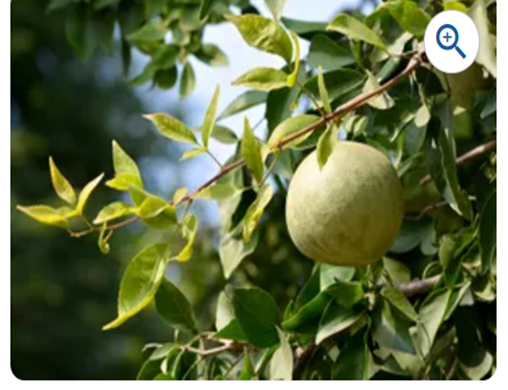
Fig (1.1): Bael Leaf And Fruit 5
Monograph Of Bael Plant:
Synonyms: Other names for this plant include Bengal quince, golden apple, stone apple, and wooden apple. Origin in Biology
Biological source: It includes both fresh and fully dried plant material obtained from the Aegle marmelos plant.
Family: Rutaceae
Chemical Constituent:
1. Alkaloids: Angeline, N-methylisocorydine, and O-methylisocorydine 2. Flavonoids: Quercetin, Kaempferol, and Ruti
3.Phenolic acids: Gallic acid, Ellagic acid, and Ferulic acid 4.Terpenoids: ?-Sitosterol, Stigmasterol, and Lupeol 5. Glycosides: Aeglemarmeloside, Marmin, and Marmelin
Bioactive Compounds with Anti-Inflammatory and Antioxidant Activity:
1. Angeline: Inhibits pro-inflammatory cytokines and oxidative stress
2. Quercetin: Anti-inflammatory, antioxidant, and immunomodulatory effects
3. Gallic acid: Antioxidant, anti-inflammatory, and antimicrobial properties
4. Lupeol: Anti-inflammatory, antioxidant, and anticancer activities 6
Uses:
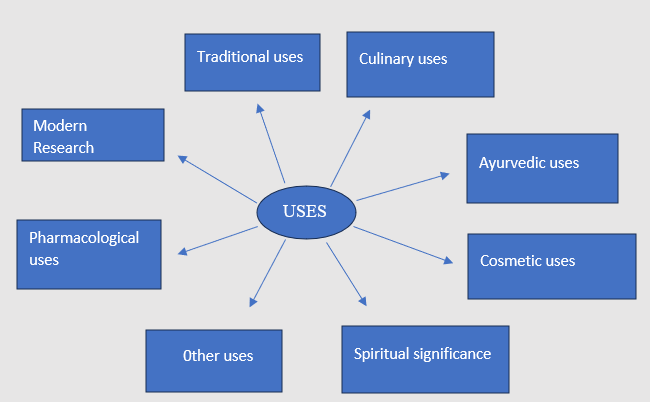
Fig: (1.2) uses of bael 7
Various Bael preparations:
1.Decoction
Preparation: Boil 10-20 g of Bael leaves or roots in 400 ml water for 10-15 minutes.
Uses: Digestive issues, fever, respiratory problems.
2.Infusion
Preparation: Steep 5-10 g of dried Bael leaves in 200 ml boiling water for 5-10 minutes.
Uses: Anxiety, stress, insomnia.
3.Powder
Preparation: Dry and grind Bael leaves or roots into a fine powder.
Uses: Digestive issues, skin conditions, as a supplement.
4.Juice
Preparation: Extract juice from fresh Bael fruit.
Uses: Digestive issues, immune system support.
5.Oil
Preparation: Extract oil from Bael seeds or leaves using solvent extraction.
Uses: Skin conditions, hair care, anti-inflammatory.
6.Tea
Preparation: Steep 1-2 teaspoons of dried Bael leaves in 200 ml boiling water for 5-10
minutes.
Uses: Digestive issues, respiratory problems, relaxation.8
7.Capsules/Tablets
Preparation: Dry and process Bael extract into capsules or tablets.
Uses: Digestive issues, immune system support, anti-inflammatory.
8.Ayurvedic Formulations
Preparation: Combine Bael with other herbs to create formulations like Triphala or
Hingvastaka.
Uses: Digestive issues, immune system support, respiratory problem 3
Morphological character:
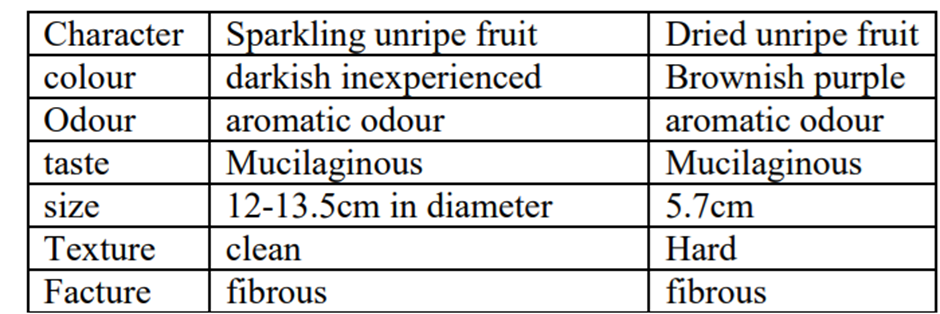
What is ulcerative colitis:
UC is categorized by medical professionals according to the location of colon inflammation. Your rectum, which is near your anus (butthole), is typically where the inflammation begins. Your colon may become completely or partially inflamed. Types consist Ulcerative colitis (UC) is a chronic illness that results in ulcers and inflammation in the large intestine, or colon. Along with Crohn's disease, ulcerative colitis (UC) is one of the most prevalent forms of inflammatory bowel disease (IBD). Abdominal cramps and bloody diarrhoea are common symptoms of UC. You might have to poop more as a result. Most UC patients have flare-ups, or episodes of symptoms, followed by prolonged remissions, or times when they don't have any symptoms.10
Ulcerative Colitis Type:
The location of ulcerative colitis in your body determines its type:
1.Ulcerative Proctitis: The mildest type of proctitis is typically ulcerative. Only the rectum, the section of your colon nearest your anus, has it. The condition may simply manifest as rectal bleeding.
2.Proctosigmoiditis: Your rectum may refer to as the sigmoid colon are affected and the bottom portion of your colon—what the doctor by proctosigmoiditis. You will experience agony, cramping in your abdomen, and bloody diarrhea. The urge to poop will be strong, but you won't be able to. (Your physician might refer to this as tenesmus).
3.Left-sided colitis: Cramps on the left side of your abdomen are a symptom of left-sided colitis. In addition to experiencing bloody diarrhea, you may lose weight unintentionally. From your rectum through the left part of your colon, you will have inflammation.
4.Pancolitis: Your entire colon is frequently affected by pancolitis. Severe episodes of bloody diarrhea, cramping in the abdomen, pain, exhaustion, and significant weight loss are all possible side effects. 11
5.Acute severe ulcerative colitis: Rarely does acute severe ulcerative colitis occur. It produces extreme pain, profuse diarrhea, bleeding, and fever, and it affects your entire colon. 12
Symptoms of Ulcerative Colitis
1.Bloody diarrhea is ulcerative colitis's primary symptom. Your stools may also contain some pus.
2.Other issues consist of:
3.Abdominal ache that is cramping
4.Unexpected desire to urinate
5.Not feeling hungry
6.Loss of weigh
7.Experiencing fatigue
8.A fever
9.Dehydration
10.Soreness or pain in the joints
11.Canker sores
12.Pain in the eyes from staring at bright lights
13.Anemia, or low red blood cell count
14.Sores on the skin.
15.Having the sensation that your colon has not been fully emptied after using the restroom
16.Getting up late to go
17.Being unable to keep your stool in place
18.Bowel movement pain or blood 19. It's possible for your symptoms to flare up, disappear, and then return. Weeks or years may pass before you have any. 13

Fig (1.3) Ulcerative colitis 13
Causes:
Scientists think that an overactive immune system could be the cause of UC. Why certain immune systems react by targeting the large intestine while others do not is unknown, though. The majority of UC patients have no family history of the illness. Nonetheless, between 8 and 14% of UC patients do have a family relative with IBD. Although it can affect persons of any ethnicity, white people are more likely to acquire UC. Being Ashkenazi Jewish increases your risk of contracting the illness compared to most other populations. In addition to your genes, environmental variables such as bacteria, viruses, or antigens that might activate your immune system, as well as other immunological illnesses you may have, may influence who develops UC.14
Risk elements:
Although ulcerative colitis can strike anyone, your risk is higher if you have:
1.Age: Most persons receive a diagnosis when they are over 60 or between the ages of 15 and 30.
2.Race and ethnicity: White people, particularly those of Ashkenazi Jewish heritage, are more likely to develop UC.
3.Genetics: If a parent, sibling, or child has UC, you have a higher chance of getting it yourself. Up to 20% of UC patients have a family member who also has Crohn's disease or UC.
4.Gut microbiota: The bacteria, viruses, and fungi that live in your digestive tract make up your gut microbiome. Consider it the environment of your gut. The microbiomes of individuals with UC differ from those of those without the condition. The reason is unknown to researchers.
Other factors, like stress and your diet, do not increase your risk of developing UC, but they can trigger a symptom flare-up. One of the best things you can do if your diagnosed with UC is to note your triggers so you can avoid them. 15
Management and Treatment
How is ulcerative colitis treated?
If yours having a flare-up, the aim of treatment is to send you into remission; if you're not experiencing symptoms at the moment, it's to help you stay in remission. Medication and surgery are available as forms of treatment.
Drugs
Medical professionals employ a number of drugs, either separately or in combination, to reduce inflammation in the large intestine. The tissue can mend if the edema and inflammation are reduced. Additionally, it can alleviate your symptoms, reducing discomfort and diarrhea.
UC medications include:
1.Aminosalicylates: For mild to moderate ulcerative colitis, your doctor may recommend sulfasalazine (Azulfidine®). Inform your healthcare practitioner if you have a sulpha allergy. Instead, they might recommend mesalamine or another sulpha-free amino salicylate (Canasa®, Delzicol®, Asacol® HD, Pentasa®, Lialda®, Apriso®).
2.Corticosteroids: You could require a corticosteroid, such as budesonide (Entocort® EC, Uceris®) or prednisone (Deltasone®), if you have a severe form of ulcerative colitis. Medical professionals only advise short-term usage of corticosteroids due to their severe negative effects.
3.Immunosuppressants: To soothe your immune system, your doctor can suggest an immunosuppressant. These medications include methotrexate (Trexall®), azathioprine (Azasan® and Imuran®), and 6-mercaptopurine (Purixan®, Purinethol®).
4.Biologics: By reducing certain aspects of your immune response, biologics cure moderate to severe ulcerative colitis. Biologics include drugs like ustekinumab (Stelara®), certolizumab pegol (Cimzia ®), vedolizumab (Entyvio ®), adalimumab (Humira ®), golimumab (Simponi ®), and infliximab (Remicade ®).
5.Drugs known as Janus kinase (JAK) inhibitors are tiny molecules: Medications such as tofacitinib (Xeljanz®) prevent inflammation by blocking one of your body's enzymes. Ozanimod (Zeposia®) and upadacitinib (RinvoQ®) are other JAK inhibitors.
Surgery
If your medication is not working or you are having major side effects, surgery may be your best bet. Approximately 30% of patients with ulcerative colitis eventually require surgery. Surgery is required for 20% of kids with ulcerative colitis. For ulcerative colitis, there are two types of surgery available. Both require a proctocolectomy, which is a surgical procedure in which your colon and rectum are removed entirely or in part.
1.Proctocolectomy and ileal pouch:
In patients with ulcerative colitis, the most common procedure is a proctocolectomy and ileal pouch. Your anus is left intact during this treatment, but your colon and rectum are removed. After that, the surgeon creates an ileal pouch, which is a piece of tiny intestine that joins your anus.
2.Proctocolectomy and ileostomy:
Your medical team may suggest a permanent ileostomy (without an ileal pouch) if an ileal pouch is not an option. Your colon, rectum, and anus are removed by your surgeon. They create a hole in your abdomen that connects to an external pouch (ileal stoma) that holds waste. You will frequently empty the bag. 16
Antiulcer activity:
Helicobacter pylori infections or the use of nonsteroidal anti-inflammatory medication capsules can both cause ulcers, a common gastrointestinal tract condition. This results in the upper gastrointestinal tract being exposed to acid-pepsin secretions. Likewise, to assess Bael's effectiveness against gastric ulcers, oral administration of 1 g/kg of Bael leaf aqueous extract for 21 days against Helicobacter pylori lipopolysaccharide-induced gastric ulcer in rats demonstrated a significant decrease in the ulcer's responsible compound for antihyperglycemic hobby lesion remember, the volume of gastric juice, and acidity, as well as an increase in pH and hexosamine.17 Bael fruit in traditional medicine: Bael culmination is regarded as an excellent treatment for diarrhea in the Ayurvedic drug system (Das & Das, 1995). The unripe final product helps with digestion and stomach infections and has bitter, acrid, sour, and astringent Flavors. The half-ripe fruit has anti-diarrheal, digestive, and astringent properties. Ripe fruits are utilized to prevent sub-acute and chronic dysentery and are thought to be more useful than uncooked ones. The fruit pulp prevents diarrhea by acting as a gentle stimulant to the intestinal mucous membrane. The mature fruit is cooling, laxative, and fragrant. 18
What side effects might ulcerative colitis cause?
Complications from ulcerative colitis can arise over time and include
1.You have fewer red blood cells than usual if you have anemia. Multiple forms of anemia, such as iron-deficiency anemia (NIH external link) and anemia of inflammation or chronic disease, can result from ulcerative colitis.
2.bone issues because the corticosteroids used to treat ulcerative colitis can have an impact on the bones. Low bone mass NIH external link conditions like osteopenia or osteoporosis are examples of bone issues.
3.issues with children's growth and development, like delayed puberty, sluggish growth, short stature, or less weight gain than usual NIH external link.
4.colorectal cancer, as individuals with chronic ulcerative colitis affecting a third or more of the colon are more vulnerable and need to be screened more closely.
Ulcerative colitis can occasionally result in severe side effects that worsen rapidly and have the potential to be fatal. Emergency surgery or hospital care are necessary for these problems.
a. Serious issues consist of More than ten bloody bowel movements in a day, together with fever, a fast heartbeat, and severe anemia, are among the symptoms of fulminant ulcerative colitis. Individuals with fulminant ulcerative colitis are more likely to experience perforation and toxic megacolon, among other consequences.19 b. perforation, which is a hole in the large intestine's wall.
c. passing a large amount of blood from the rectum or experiencing acute rectal bleeding. d. Emergency surgery may be necessary in certain cases of severe or heavy rectal bleeding in patients with ulcerative colitis. poisonous megacolon, which happens when inflammation reaches the large intestine's deep tissue layers, causing it to enlarge and malfunction. Dehydration and severe anemia are two other issues that can arise from severe ulcerative colitis or major consequences. Treatment for these issues may involve intravenous (IV) fluids and electrolytes or blood transfusions at a hospital (NIH external link).20
Health problems affecting other parts of the body
In addition to the large intestine, some patients with ulcerative colitis also have inflammation in other areas of their bodies, such as the
1.joints, leading to certain forms of arthritis External link NIH
2.skin 3.eyes 4.bile ducts and liver, leading to diseases such primary sclerosing cholangitis Additionally, blood clots in the blood arteries are more likely to occur in people with ulcerative colitis.
Colorectal cancer
The risk of colon cancer is increased by ulcerative colitis NIH external link. If ulcerative colitis involves more of the large intestine, is more severe, began earlier in life, or has persisted for a longer period of time, a person is at a higher risk of getting colorectal cancer. Having primary sclerosing cholangitis or a family history of colorectal cancer increases the risk of colorectal cancer in people with ulcerative colitis. (25) Your doctor could suggest a colonoscopy to check for colorectal cancer if you have ulcerative colitis. Testing for diseases while you do not have any symptoms is called screening. Screening can detect colorectal cancer or dysplasia, which are precancerous cells. Early cancer diagnosis can increase recovery chances.Doctors usually advise colonoscopies for patients with ulcerative colitis every one to three years, beginning eight years after the onset of the condition. (25) From the time of diagnosis, clinicians usually recommend annual colonoscopies for patients with ulcerative colitis and primary biliary cholangitis.21
How do healthcare providers diagnose colon cancer?
Healthcare providers use several tests to diagnose colon cancer. Those tests include
1.Total blood count (CBC). 2.CMP stands for comprehensive metabolic panel. 3.Assay for carcinoembryonic antigen (CEA): CEA is released into the bloodstream by both cancerous and healthy cells.
4.X-rays. 5.CT scan (computed tomography).
6.scan using magnetic resonance imaging (MRI)
7.PET scan (positron emission tomography). 8.ultrasound.
9.biopsy.

Fig (1.4) colorectal colon cancer 22
How common is ulcerative colitis?
According to research, between 600,000 and 900,000 Americans suffer with ulcerative colitis. 23.
Dosage and preparation:
1.Bael fruit extract: 500-1000mg/day 2. Bael leaf extract:200-500mg/day 3. Bael tea:1-2 cups/day.
Mechanism of bael act on ulcerative colitis
Ingestion

Absorption

Bioactive Compounds
Alkaloids (Angeline- methylisocorydine) Flavonoids (quercetin, kaempferol
Phenolic acids (gallic acid, ellagic acid) Terpenoids (lupeol)

Anti-Inflammatory Pathway
Inhibit pro-inflammatory cytokines
Inhibit enzymes (COX-2, LOX) Reduce inflammation

Antioxidant Pathway
Scavenge free radical Reduce oxidative stress Protect gut mocosa

Immunomodulatory Pathway
Modulate immune response Suppress excessive inflammation

Gastroprotective Pathway
Protect gut mucosa Reduce ulceration
Prebiotic Pathway
Promote beneficial gut microbiota
Maintain healthy gut barrier

Reduced Inflammation

Improved Gut Health

Symptom Relief(UC) 24
Herbal Medicine:
The Latin word herba, which means "grass," is where the word "herb" originates. Plants whose leaves, stems, or fruit are used for food, medicine, or for their flavour or aroma have been referred to by this name. The term "herbal medicine" describes traditional and folk medicine that uses plants and plant extracts to heal illnesses. Native Americans virtually always employ herbs to treat illnesses. By the end of the twentieth century, a variety of traditions had taken over the practice of herbal therapy in the West. One of the most popular TCM methods is herbal medicine. According to estimates, 28.9% of adults in the US frequently utilize one or more TCM therapies, with herbal items accounting for 9.6% to 12.1% of these treatments.[13] According to recent studies, between 20% and 26% of adults utilize TCM therapies for their gastrointestinal symptoms; however, patients with functional GI problems and those with chronic GI issues are more prone to use them. 25 In Eastern Asian nations, TCM is currently commonly used to treat UC. According to Langmead et al., slippery elm, fenugreek, devil's claw, Mexican yam, tormentil, and Wei tong Ning (a TCM) are herbal treatments used to treat IBD. 26
Following is herbal medicine for ulcerative colitis:
1.Alo-vera:
In Indian, Chinese, Egyptian, and European traditions, the mucilaginous gel derived from the leaf pulp of the perennial succulent Aloe vera (Aloe barbadensis Miller) has been used medicinally to treat cancer, osteoporosis, gastrointestinal disorders, and skin wounds (34,35). The anthraquinones found in aloe vera, such as aloe-emodin and its c-glycoside, aloin, which have the ability to scavenge peroxyl radicals, are largely responsible for the plant's anti-inflammatory and antioxidant qualities. 27 By promoting mucin expression and thickening the mucus layer, aloe vera is believed to improve the function of the intestinal barrier, reducing inflammation and colonic tissue damage. 28

Fig No (1.5) Alo-vera 29
2.Curcumin
inflammatory properties. It has been discovered to stimulate bile flow, which aids in fat breakdown. It may also lessen the amount of acid the stomach secretes and guard against damage from certain drugs, stress, or alcohol, such as ulcers on the intestinal walls or inflammation along the stomach (gastritis). Curcumin supplementation improved the condition of five out of five patients with chronic ulcerative proctitis in a preliminary experiment. Curcumin prevents NF-?B from being activated. Numerous antioxidant enzymes are synthesized with the help of NF-?B. Thioredoxin reductase's activity is irrevocably changed from an antioxidant to a potent pro Turmeric (Curcuma longa) contains a chemical called curcumin, which has been shown to have anti-oxidant when curcumin binds to it directly. For one month, 550 mg of curcumin was taken twice daily, and then 550 mg three times daily.30
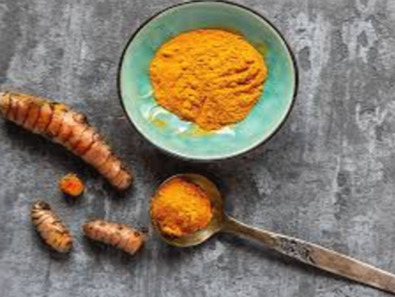
Fig (1.6) Curcumin 31
3.The Triticum aestivum, or wheat grass
Numerous gastrointestinal disorders have been treated using wheat grass juice. According to a double-blind study, 78% of UC patients who take wheat grass juice supplements for a month see clinical improvement, whereas only 30% of those who get a placebo do so. 32
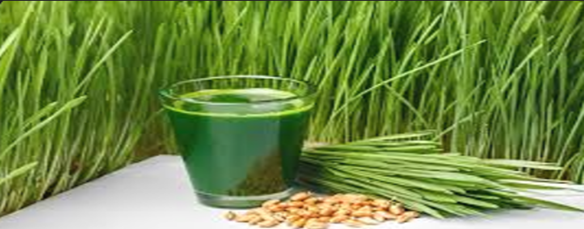
Fig No (1.6) Triticum aestivum or wheat grass 33
Liquorice:
Derived from the plant's root, liquorice is widely used in Traditional Chinese Medicine (TCM) to treat a wide range of illnesses. Additionally, liquorice possesses adaptogenic and immune-modulatory properties that are necessary for the pathophysiology of ulcerative colitis. Glycyrrhizin is one of several active compounds that are believed to be responsible for its biologic activity. A compound that is isolated and refined from liquorice, diammonium glycyrrhizinate, has potential applications in the management of ulcerative colitis.34Additionally, there is evidence that diammonium glycyrrhizinate may alleviate intestinal mucosal inflammation in rats and, crucially, lower the production of TNF-?, ICAM-1, and NF-?B in inflammatory mucosa.35 liquorice has also been shown to be useful in the treatment of ulcerative colitis in clinical trials conducted in conjunction with other herbs.
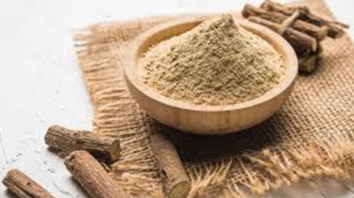
Fig (1.7) Liquorice36
Preparation of Bael fruit powder
The fruits' hard exocarps were carefully shattered. The pulp was then taken out of the shell and placed in a sterile stainless-steel container. Three different categories were used to classify the samples. Sample-I is the pulp for this specific group. This is made up of seeds and gum. Additionally, Sample-II is made of gum, whereas excluding seeds at the same time. However, Sample-III is distinguished by pulp. free of gum and seeds. After that, the samples were allowed to dry in warm air. oven (Mummert GmbH + Co. KG, Buschbacher, Germany; Universal Oven UN55) at a 60 ± 5 ?C was reached. The dried specimens were then meticulously mixed. (JP1009, Maharashtra, India, Japan Industries Ltd.) and sieved using sieve number 18, which has a 1 mm mesh size. To aid in subsequent research, the powder was both hermetically sealed in a glass container and kept at room temperature at a ± 5 ?C was the temperature.
Procedure Of Bael Fruit Powder Preparation
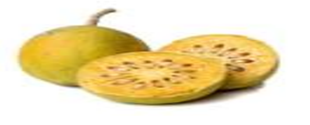
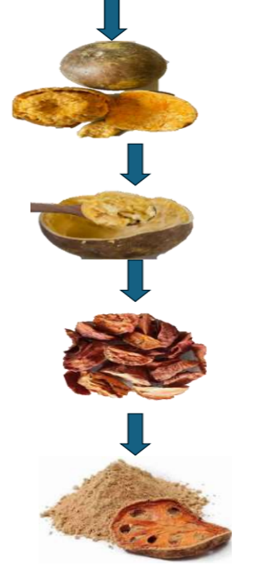
Fig no. (1.8) Bael fruit preparation37
Medicinal Importance
1.Anticancer Activity:
One of the leading causes of death globally is cancer. Because of the severity of the illness and the side effects of the medication used to treat it, researchers are searching for alternative natural sources of treatment. In an investigation using the leaf extract of It was found to have anticancer effects, Bael. When carried out in a separate cell such as leukemic K562, erythroleukemic HEL, Typhoid Jurkat, and melanoma Colo38 ?-lymphoid and breast cancer cell lines (MDAMB 231). Similarly, the substance Bael marmelin has antitumor qualities against colon cancer in humans. (HCT-116), alveolar epithelial cancer cells, and human epithelial type 2 (HEp2) by causing apoptosis by inhibiting the development of malignant cells. 38
2.Antimicrobial Activity:
Several in vitro investigations have revealed that the various extracts of the Bael plant inhibit a broad range of harmful microorganisms, such as bacteria, fungi, and viruses. Rani and Khullar's investigation found that the methanolic extract of Bael was found to be efficient against Salmonella typhi. Likewise, in a different study, the Ethanolic extract demonstrated antibacterial properties against Staphylococcus aureus, E. coli, Bacillus subtilis, and Pseudomonas aeruginosa. 39
3.Antidiabetic action
It has been demonstrated that bael extracts significantly improve antidiabetic sports when used in animal styles.[11] Bael fruit extracts have been shown to have protective effects.
on the pancreatic tissues of rats with diabetes. Alcoholic and aqueous extracts of the final product caused hyperglycaemia when administered at a dosage of 500 mg per kilogram of body weight. in rabbits. An increase in the amount of vitamin C in the diet was followed by hyperglycaemia after bael fruit extracts were given to mice.40
4.Antifungal action
Aegle marmelos leaves have been shown to have antifungal properties against clinical isolates of dermatophytes. A. Extracts and fractions of marmelos leaves were discovered to contain action that inhibits Trichophyton mentagrophytes, Microspore Canis, M. gypsum, T. rubrum, floccosum Epidermophyton.41
5.Antidiarrheal Properties
The antidiarrheal properties of dried fruit pulps in vitro There were reports of Aegle marmelos. The antidiarrheal effect was carried out using the MIC technique to combat the cause diarrheal organisms. The extract of ethanol exhibits good action against S. sonnei, S. flexneri, and Shigella boydii mild in comparison to S. dysenteriae. 42
6.Anti-fertility
Male Albino rats treated with aqueous extracts of Aegle marmelos leaves have antifertility effects. The rats were given 250 mg/kg body as aqueous extracts. weight) for forty-five days. This therapy led to a decrease in in the seminal vesicle, testis, and epididymes' weights. Additionally, the extract caused a decrease in testicular sperm. count, motility, and epididymal sperm count and abnormal number of sperm. 43

CONCLUSION:
The medicinally significant plant bael (Aegle marmelos L.) has demonstrated exceptional promise in enhancing human health and providing therapeutic advantages. This thorough analysis emphasizes its extensive phytochemical profile, which includes tannins, coumarins, alkaloids, and flavonoids and contributes to its varied pharmacological characteristics. Bael is a useful natural treatment for a number of illnesses due to its proven anti-inflammatory, anti-oxidant, antibacterial, antidiabetic, hepatoprotective, and cardioprotective properties. Notably, its chemopreventive and antitumor properties create new opportunities for cancer research and therapy. Although the advantages of traditional medicine have long been acknowledged, recent scientific research provide strong proof in favour of their application in the creation of nutraceuticals and therapeutic uses. To completely confirm its therapeutic potential and guarantee safe and efficient formulations, additional clinical research is required.
REFERENCES
- Lomate KA, Murthy K, Adak VS, Shete RV V. A review on phytochemical and pharmacological values of Aegle marmelos. J Drug Deliv Ther. 2021;11(2-S):162-166. doi:10.22270/jddt.v11i2-s.4645
- Head KA, Jurenka JS, Ascp MT. Inflammatory_bowel_disease_Part_1_ulcera. 2003;8(3)
- Thekkan S, Paulsamy S. Ethnobotanical informations on the species of selected areas in Nilgiri Biosphere Reserve, the Western Ghats. jresearchbiology.com J Res Biol An Int Sci Res J J Res Biol An Int Sci Res J. 2015;5(July):43-57. http://jresearchbiology.com/
- Kumar S, Suman, Sharma S, Kalra P. Antiulcer effect of the methanolic extract of Tamarindus indica seeds in different experimental models. J Pharm Bioallied Sci. 2011;3(2):236-241. doi:10.4103/0975-7406.80778
- Mr. Gaurav Vitthal Ingole, Mr, Abhishek Sridhar Chaudhari, Ms, Pranali Dilip Dhole, Mr. Vivek Subhash Rathod. A Research on Formulation and Evaluation of Herbal Shampoo. Int J Adv Res Sci Commun Technol. 2024;13(18):556-560. doi:10.48175/ijarsct-18683
- Parveen S, Rasool G, Hassan M, Dehghan G, Dehghan MH. A comprehensive review on medicinal plant: Aegle marmelos (linn) correa. Eur J Pharm Med Res www.ejpmr.com ?. 2022;9(4):193. https://www.researchgate.net/publication/359693482
- Sharma N, Palia P, Chaudhary A, Shalini , Verma K, Kumar I. A Review on Pharmacological Activities of Lupeol and its Triterpene Derivatives. J Drug Deliv Ther. 2020;10(5):325-332. doi:10.22270/jddt.v10i5.4280
- Gavali J. Review of bilva (aegle marmelos) w.s.r. to charaka samhita. 2024;(January 2022). doi:10.20959/wjpps20228-22725
- Kahkeshani N, Farzaei F, Fotouhi M, et al. Pharmacological effects of gallic acid in health and disease: A mechanistic review. Iran J Basic Med Sci. 2019;22(3):225-237. doi:10.22038/ijbms.2019.32806.7897
- Rubin DT, Ananthakrishnan AN, Siegel CA, Sauer BG, Long MD. ????????????????????????. Am J Gastroenterol. 2019;114(3):384-413.
- Holubar SD, Lightner AL, Poylin V, et al. The American Society of Colon and Rectal Surgeons Clinical Practice Guidelines for the Surgical Management of Ulcerative Colitis. Dis Colon Rectum. 2021;64(7):783-804. doi:10.1097/DCR.0000000000002037
- Tripathi K, Feuerstein JD. New developments in ulcerative colitis: Latest evidence on management, treatment, and maintenance. Drugs Context. 2019;8:1-11. doi:10.7573/dic.212572
- Gracie DJ, Ford AC. IBS-like symptoms in patients with ulcerative colitis. Clin Exp Gastroenterol. 2015;8:101-109. doi:10.2147/CEG.S58153
- Lakatos PL, Lakatos L. Risk for colorectal cancer in ulcerative colitis: Changes, causes and management strategies. World J Gastroenterol. 2008;14(25):3937-3947. doi:10.3748/wjg.14.3937
- Soiza RL, Donaldson AIC, Myint PK. Vaccine against arteriosclerosis: an update. Ther Adv Vaccines. 2018;9(6):259-261. doi:10.1177/https
- Langmead L, Rampton DS. Review article: Complementary and alternative therapies for inflammatory bowel disease. Aliment Pharmacol Ther. 2006;23(3):341-349. doi:10.1111/j.1365-2036.2006.02761.x
- Xu CT, Meng SY, Pan BR. Drug therapy for ulcerative colitis. World J Gastroenterol. 2004;10(16):2311-2317. doi:10.3748/wjg.v10.i16.2311
- Comar KM, Kirby DF. Herbal remedies in gastroenterology. J Clin Gastroenterol. 2005;39(6):457-468. doi:10.1097/01.mcg.0000165650.09500.3a
- Granados-Romero JJ, Valderrama-Treviño AI, Contreras-Flores EH, et al. Colorectal cancer: a review. Int J Res Med Sci. 2017;5(11):4667. doi:10.18203/2320-6012.ijrms20174914
- Yashiro M. Ulcerative colitis-associated colorectal cancer. World J Gastroenterol. 2014;20(44):16389-16397. doi:10.3748/wjg.v20.i44.16389
- Kappelman MD, Moore KR, Allen JK, Cook SF. Recent trends in the prevalence of Crohn’s disease and ulcerative colitis in a commercially insured US population. Dig Dis Sci. 2013;58(2):519-525. doi:10.1007/s10620-012-2371-
- Holtedahl K, Borgquist L, Donker GA, et al. Symptoms and signs of colorectal cancer, with differences between proximal and distal colon cancer: a prospective cohort study of diagnostic accuracy in primary care. BMC Fam Pract. 2021;22(1):1-13. doi:10.1186/s12875-021-01452-6
- Shivashankar R, Tremaine WJ, Harmsen WS, Loftus E V. Incidence and Prevalence of Crohn’s Disease and Ulcerative Colitis in Olmsted County, Minnesota From 1970 Through 2010. Clin Gastroenterol Hepatol. 2017;15(6):857-863. doi:10.1016/j.cgh.2016.10.039
- Pathirana CK, Madhujith T, Eeswara J. Bael (Aegle marmelos L. Corrêa), a Medicinal Tree with Immense Economic Potentials. Adv Agric. 2020;2020. doi:10.1155/2020/8814018
- Tillisch K, Tillisch K, Med C. Tillisch. Published online 2007:224-227.
- Langmead L, Feakins RM, Goldthorpe S, et al. Randomized, double-blind, placebo-controlled trial of oral aloe vera gel for active ulcerative colitis. Aliment Pharmacol Ther. 2004;19(7):739-747. doi:10.1111/j.1365-2036.2004.01902.x
- Sánchez M, González-Burgos E, Iglesias I, Gómez-Serranillos MP. Pharmacological update properties of aloe vera and its major active constituents. Molecules. 2020;25(6):1-37. doi:10.3390/molecules25061324
- Moghaddasi S, Verma SK, Publications B. Aloe vera their chemicals composition and applications: A review a b International Journal of BIOLOGICAL AND MEDICAL RESEARCH. Int J Biol Med Res Int J Biol Med Res Int J Biol Med Res. 2011;2(1):466-471.
- Ba?an BJ, Niemcewicz M, Kocik J, Jung L, Skopi?ska-RÓZEWSKA E, Skopi?ski P. Oral administration of Aloe vera gel, anti-microbial and anti-inflammatory herbal remedy, stimulates cell-mediated immunity and antibody production in a mouse model. Cent Eur J Immunol. 2014;39(2):125-130. doi:10.5114/ceji.2014.43711
- Ammon HPT, Wahl MA. Pharmacology of Curcuma longa. Planta Med.,. Planta Med. 1991;57:1–7.
- Günbatan T. Curcuma longa L. Nov Drug Targets with Tradit Herb Med Sci Clin Evid. 2022;74(2):191-208. doi:10.1007/978-3-031-07753-1_14
- Beniwal A, Das M, Bhattacharyya P. Therapeutic Uses of Wheatgrass Juice. 2022;(August 2023). https://www.researchgate.net/publication/373118410
- Minocha N, Saini S, Pandey P. Nutritional prospects of wheatgrass (Triticum aestivum) and its effects in treatment and chemoprevention. Explor Med. 2022;3(5):432-442. doi:10.37349/emed.2022.00104
- Svkm ’s MD, Nanavati B, Damle M. Glycyrrhiza glabra (Liquorice) -a potent medicinal herb. Int J Herb Med IJHM. 2014;2(22):132-136.
- Yang R, Wang LQ, Yuan BC, Liu Y. The Pharmacological Activities of Licorice. Planta Med. 2015;81(18):1654-1669. doi:10.1055/s-0035-1557893
- Bahmani M, Rafieian-Kopaei M, Jeloudari M, et al. A review of the health effects and uses of drugs of plant licorice (Glycyrrhiza glabra L.) in Iran. Asian Pacific J Trop Dis. 2014;4(S2):S847-S849. doi:10.1016/S2222-1808(14)60742-8
- Bhattacharya A, Chatterjee A, Ghosal S, Bhattacharya SK. Antioxidant activity of active tannoid principles of Emblica officinalis (amla). Indian J Exp Biol. 1999;37(7):676-680.
- Blessy S, Devi RG, Selvaraj J, Priya AJ. Anticancer Potential of A. marmelos Fruit Extract in Human Colon Cancer Cell Lines is Mediated through the Regulation of EMT Signalling Molecules. J Pharm Res Int. 2021;33:2355-2362. doi:10.9734/jpri/2021/v33i60b34884
- Sarkar T, Salauddin M, Chakraborty R. In-depth pharmacological and nutritional properties of bael (Aegle marmelos): A critical review. J Agric Food Res. 2020;2(October):100081. doi:10.1016/j.jafr.2020.100081
- Mallesh Y. Health Benefits and Therapeutic Potential of Bael ( Aegle marmelos L .): A Comprehensive Review. 2024;(January).
- Vinita Bisht N, Johar V. Bael (Aegle marmelos) Extraordinary Species of India: A Review. Int J Curr Microbiol Appl Sci. 2017;6(3):1870-1887. doi:10.20546/ijcmas.2017.603.213
- Dutta A, Lal N, Naaz M, Ghosh A, Verma R. Ethnological and Ethno-medicinal Importance of Aegle marmelos (L.) Corr (Bael) Among Indigenous People of India. Am J Ethnomedicine. 2014;1(5):290-312. www.ajethno.comhttp://www.ajethno.com
- Srivastava AK, Singh VK. Anti-Fertility Role of Aegle Marmelos (Bael). J Appl Heal Sci Med. 2022;2(November):21-25. https://www.researchgate.net/profile/Arun-Srivastava 4/publication/365447562_Anti-Fertility_Role_of_Aegle_Marmelos_Bael/links/637594002f4bca7fd0686eeb/Anti-Fertility-Role-of-Aegle-Marmelos-Bael.pdf


 Vaishnavi Hande*
Vaishnavi Hande*
 Vaishnavi Jadhav
Vaishnavi Jadhav
 Dr. Gajanan Sanap
Dr. Gajanan Sanap













 10.5281/zenodo.14577166
10.5281/zenodo.14577166